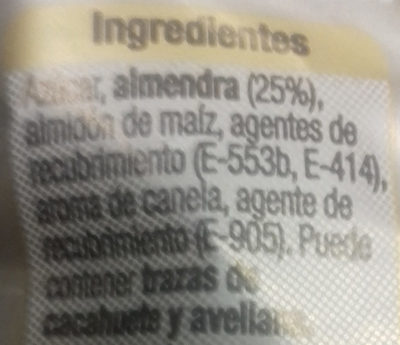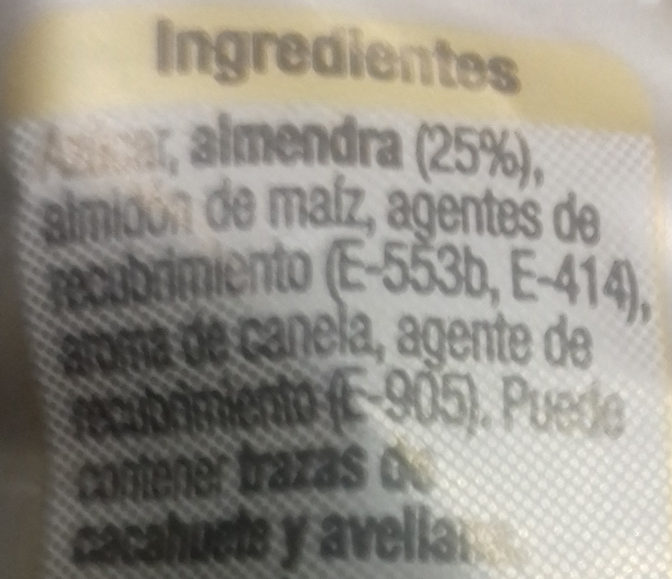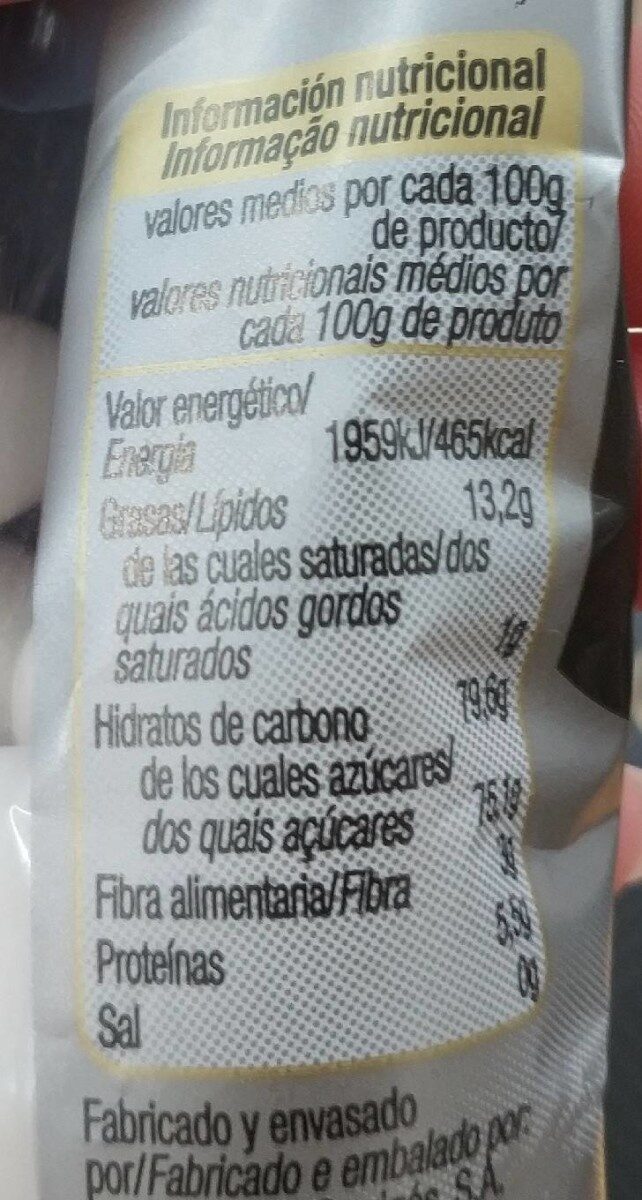Help us make food transparency the norm!
As a non-profit organization, we depend on your donations to continue informing consumers around the world about what they eat.
The food revolution starts with you!
Peladillas - Alteza - 100 g
Peladillas - Alteza - 100 g
This product page is not complete. You can help to complete it by editing it and adding more data from the photos we have, or by taking more photos using the app for Android or iPhone/iPad. Thank you!
×
Barra-kodea: 8480024775726 (EAN / EAN-13)
Izen arrunta: Peladillas. Calidad suprema
Kopurua: 100 g
Ontziratzea: en:Plastic, en:Bag
Markak: Alteza
Kategoriak: en:Plant-based foods and beverages, en:Plant-based foods, en:Snacks, en:Sweet snacks, en:Confectioneries, en:Nuts and their products, en:Nut confectioneries, en:Dragées, en:Sugar coated almonds
Etiketak, ziurtagiriak, sariak: en:No gluten, es:Calidad suprema
Manufacturing or processing places: España
Dendak: Alteza
Saltzen diren herrialdeak: Espainia
Matching with your preferences
Health
Osagaiak
-
9 ingredients
: Azúcar, almendra (25%), almidón de maíz, agentes de recubrimiento (E-553b, E-414), aroma de canela, agente de recubrimiento (E-905).Alergenoak: en:NutsAztarnak: en:Nuts, en:Peanuts
Food processing
-
Ultra processed foods
Elements that indicate the product is in the 4 - Ultra prozesatutako elikagaiak eta edariak group:
- Gehigarria: E414
- Gehigarria: E905
- Osagaia: Glazing agent
Food products are classified into 4 groups according to their degree of processing:
- Prozesatu gabeko edo ahalik eta gutxien prozesatutako elikagaiak
- Sukaldaritzako osagaiak prozesatu
- Prozesatutako jakiak
- Ultra processed foods
The determination of the group is based on the category of the product and on the ingredients it contains.
Gehigarriak
-
E414
Gum arabic: Gum arabic, also known as acacia gum, arabic gum, gum acacia, acacia, Senegal gum and Indian gum, and by other names, is a natural gum consisting of the hardened sap of various species of the acacia tree. Originally, gum arabic was collected from Acacia nilotica which was called the "gum arabic tree"; in the present day, gum arabic is collected from acacia species, predominantly Acacia senegal and Vachellia -Acacia- seyal; the term "gum arabic" does not indicate a particular botanical source. In a few cases so‐called "gum arabic" may not even have been collected from Acacia species, but may originate from Combretum, Albizia or some other genus. Producers harvest the gum commercially from wild trees, mostly in Sudan -80%- and throughout the Sahel, from Senegal to Somalia—though it is historically cultivated in Arabia and West Asia. Gum arabic is a complex mixture of glycoproteins and polysaccharides. It is the original source of the sugars arabinose and ribose, both of which were first discovered and isolated from it, and are named after it. Gum arabic is soluble in water. It is edible, and used primarily in the food industry as a stabilizer, with EU E number E414. Gum arabic is a key ingredient in traditional lithography and is used in printing, paint production, glue, cosmetics and various industrial applications, including viscosity control in inks and in textile industries, though less expensive materials compete with it for many of these roles. While gum arabic is now produced throughout the African Sahel, it is still harvested and used in the Middle East.Source: Wikipedia (Ingeles)
-
E905
Microcrystalline wax: Microcrystalline waxes are a type of wax produced by de-oiling petrolatum, as part of the petroleum refining process. In contrast to the more familiar paraffin wax which contains mostly unbranched alkanes, microcrystalline wax contains a higher percentage of isoparaffinic -branched- hydrocarbons and naphthenic hydrocarbons. It is characterized by the fineness of its crystals in contrast to the larger crystal of paraffin wax. It consists of high molecular weight saturated aliphatic hydrocarbons. It is generally darker, more viscous, denser, tackier and more elastic than paraffin waxes, and has a higher molecular weight and melting point. The elastic and adhesive characteristics of microcrystalline waxes are related to the non-straight chain components which they contain. Typical microcrystalline wax crystal structure is small and thin, making them more flexible than paraffin wax. It is commonly used in cosmetic formulations. Microcrystalline waxes when produced by wax refiners are typically produced to meet a number of ASTM specifications. These include congeal point -ASTM D938-, needle penetration -D1321-, color -ASTM D6045-, and viscosity -ASTM D445-. Microcrystalline waxes can generally be put into two categories: "laminating" grades and "hardening" grades. The laminating grades typically have a melt point of 140-175 F -60 - 80 oC- and needle penetration of 25 or above. The hardening grades will range from about 175-200 F -80 - 93 oC-, and have a needle penetration of 25 or below. Color in both grades can range from brown to white, depending on the degree of processing done at the refinery level. Microcrystalline waxes are derived from the refining of the heavy distillates from lubricant oil production. This by-product must then be de-oiled at a wax refinery. Depending on the end use and desired specification, the product may then have its odor removed and color removed -which typically starts as a brown or dark yellow-. This is usually done by means of a filtration method or by hydro-treating the wax material.Source: Wikipedia (Ingeles)
Ingredients analysis
-
en:Palm oil free
No ingredients containing palm oil detected
Unrecognized ingredients: es:aroma-de-canelaSome ingredients could not be recognized.
We need your help!
You can help us recognize more ingredients and better analyze the list of ingredients for this product and others:
- Edit this product page to correct spelling mistakes in the ingredients list, and/or to remove ingredients in other languages and sentences that are not related to the ingredients.
- Add new entries, synonyms or translations to our multilingual lists of ingredients, ingredient processing methods, and labels.
If you would like to help, join the #ingredients channel on our Slack discussion space and/or learn about ingredients analysis on our wiki. Thank you!
-
en:Vegan status unknown
Unrecognized ingredients: es:aroma-de-canelaSome ingredients could not be recognized.
We need your help!
You can help us recognize more ingredients and better analyze the list of ingredients for this product and others:
- Edit this product page to correct spelling mistakes in the ingredients list, and/or to remove ingredients in other languages and sentences that are not related to the ingredients.
- Add new entries, synonyms or translations to our multilingual lists of ingredients, ingredient processing methods, and labels.
If you would like to help, join the #ingredients channel on our Slack discussion space and/or learn about ingredients analysis on our wiki. Thank you!
-
en:Vegetarian status unknown
Unrecognized ingredients: es:aroma-de-canelaSome ingredients could not be recognized.
We need your help!
You can help us recognize more ingredients and better analyze the list of ingredients for this product and others:
- Edit this product page to correct spelling mistakes in the ingredients list, and/or to remove ingredients in other languages and sentences that are not related to the ingredients.
- Add new entries, synonyms or translations to our multilingual lists of ingredients, ingredient processing methods, and labels.
If you would like to help, join the #ingredients channel on our Slack discussion space and/or learn about ingredients analysis on our wiki. Thank you!
-
Details of the analysis of the ingredients
We need your help!
Some ingredients could not be recognized.
We need your help!
You can help us recognize more ingredients and better analyze the list of ingredients for this product and others:
- Edit this product page to correct spelling mistakes in the ingredients list, and/or to remove ingredients in other languages and sentences that are not related to the ingredients.
- Add new entries, synonyms or translations to our multilingual lists of ingredients, ingredient processing methods, and labels.
If you would like to help, join the #ingredients channel on our Slack discussion space and/or learn about ingredients analysis on our wiki. Thank you!
: Azúcar, _almendra_ 25%, almidón de maíz, agentes de recubrimiento (e553b, e414), aroma de canela, agente de recubrimiento (e905)- Azúcar -> en:sugar - vegan: yes - vegetarian: yes - ciqual_proxy_food_code: 31016 - percent_min: 25 - percent_max: 75
- _almendra_ -> en:almond - vegan: yes - vegetarian: yes - ciqual_food_code: 15041 - percent_min: 25 - percent: 25 - percent_max: 25
- almidón de maíz -> en:corn-starch - vegan: yes - vegetarian: yes - ciqual_food_code: 9510 - percent_min: 0 - percent_max: 25
- agentes de recubrimiento -> en:glazing-agent - percent_min: 0 - percent_max: 25
- e553b -> en:e553b - vegan: yes - vegetarian: yes - percent_min: 0 - percent_max: 25
- e414 -> en:e414 - vegan: yes - vegetarian: yes - percent_min: 0 - percent_max: 12.5
- aroma de canela -> es:aroma-de-canela - percent_min: 0 - percent_max: 16.6666666666667
- agente de recubrimiento -> en:glazing-agent - percent_min: 0 - percent_max: 12.5
- e905 -> en:e905 - vegan: yes - vegetarian: yes - percent_min: 0 - percent_max: 12.5
Elikadura
-
Bad nutritional quality
⚠ ️Warning: the amount of fruits, vegetables and nuts is not specified on the label, it was estimated from the list of ingredients: 25This product is not considered a beverage for the calculation of the Nutri-Score.
Positive points: 3
- Proteinak: 3 / 5 (balioa: 6, rounded value: 6)
- Fiber: 3 / 5 (balioa: 3, rounded value: 3)
- Fruits, vegetables, nuts, and colza/walnut/olive oils: 0 / 5 (balioa: 25, rounded value: 25)
Negative points: 30
- Energia: 5 / 10 (balioa: 1959, rounded value: 1959)
- Azukreak: 10 / 10 (balioa: 75, rounded value: 75)
- Gantz saturatua: 5 / 10 (balioa: 6, rounded value: 6)
- Sodioa: 10 / 10 (balioa: 2000, rounded value: 2000)
The points for proteins are not counted because the negative points are greater or equal to 11.
Nutritional score: (30 - 3)
Nutri-Score:
-
Nutrient levels
-
Koipe in moderate quantity (13%)
What you need to know- A high consumption of fat, especially saturated fats, can raise cholesterol, which increases the risk of heart diseases.
Recommendation: Limit the consumption of fat and saturated fat- Choose products with lower fat and saturated fat content.
-
Gantz-azido ase in high quantity (6%)
What you need to know- A high consumption of fat, especially saturated fats, can raise cholesterol, which increases the risk of heart diseases.
Recommendation: Limit the consumption of fat and saturated fat- Choose products with lower fat and saturated fat content.
-
Azukre in high quantity (75%)
What you need to know- A high consumption of sugar can cause weight gain and tooth decay. It also augments the risk of type 2 diabetes and cardio-vascular diseases.
Recommendation: Limit the consumption of sugar and sugary drinks- Sugary drinks (such as sodas, fruit beverages, and fruit juices and nectars) should be limited as much as possible (no more than 1 glass a day).
- Choose products with lower sugar content and reduce the consumption of products with added sugars.
-
Gatz arrunt in high quantity (5%)
What you need to know- A high consumption of salt (or sodium) can cause raised blood pressure, which can increase the risk of heart disease and stroke.
- Many people who have high blood pressure do not know it, as there are often no symptoms.
- Most people consume too much salt (on average 9 to 12 grams per day), around twice the recommended maximum level of intake.
Recommendation: Limit the consumption of salt and salted food- Reduce the quantity of salt used when cooking, and don't salt again at the table.
- Limit the consumption of salty snacks and choose products with lower salt content.
-
-
Nutrition facts
Nutrition facts As sold
for 100 g / 100 mlCompared to: en:Sugar coated almonds Energia 1.959 kj
(465 kcal)+% 16 Koipe 13 g -% 12 Gantz-azido ase 6 g +% 369 Carbohydrates 79 g +% 11 Azukre 75 g +% 15 Fiber 3 g Proteina 6 g +% 9 Gatz arrunt 5 g +% 34.622 Fruits‚ vegetables‚ nuts and rapeseed‚ walnut and olive oils (estimate from ingredients list analysis) 25 %
Ingurumena
-
Eco-Score C - Moderate environmental impact
The Eco-Score is an experimental score that summarizes the environmental impacts of food products.→ The Eco-Score was initially developped for France and it is being extended to other European countries. The Eco-Score formula is subject to change as it is regularly improved to make it more precise and better suited to each country.Life cycle analysis
-
Average impact of products of the same category: B (Score: 62/100)
Kategoria: Sugar-coated almond
Kategoria: Sugar-coated almond
- PEF environmental score: 0.41 (the lower the score, the lower the impact)
- including impact on climate change: 1.73 kg CO2 eq/kg of product
Stage Impact Agriculture
78.2 %Processing
10.7 %Ontziratzea
5.5 %Transportation
4.5 %Distribution
1.1 %Consumption
0.0 %
Bonuses and maluses
-
Missing origins of ingredients information
Malus: -5
⚠ ️ The origins of the ingredients of this product are not indicated.
If they are indicated on the packaging, you can modify the product sheet and add them.
If you are the manufacturer of this product, you can send us the information with our free platform for producers.
-
Packaging with a medium impact
Malus: -10
Shape Material Recycling Impact Bag Plastic Altua
Eco-Score for this product
-
Impact for this product: C (Score: 47/100)
Produktua: Peladillas - Alteza - 100 g
Life cycle analysis score: 62
Sum of bonuses and maluses: -15
Final score: 47/100
-
Carbon footprint
-
Equal to driving 0.9 km in a petrol car
173 g CO² per 100g of product
The carbon emission figure comes from ADEME's Agribalyse database, for the category: Sugar-coated almond (Source: ADEME Agribalyse Database)
Stage Impact Agriculture
52.3 %Processing
19.5 %Ontziratzea
15.7 %Transportation
11.6 %Distribution
1.0 %Consumption
0.0 %
Ontziratzea
-
Packaging with a medium impact
-
Packaging parts
Bag (Plastic)
-
Bilgarriaren materialak
Material % Bilgarriaren pisua Bilgarriaren pisua produktuaren 100g-ko Plastic
-
Transportation
-
Origins of ingredients
Missing origins of ingredients information
⚠ ️ The origins of the ingredients of this product are not indicated.
If they are indicated on the packaging, you can modify the product sheet and add them.
If you are the manufacturer of this product, you can send us the information with our free platform for producers.Add the origins of ingredients for this product Add the origins of ingredients for this product
Report a problem
-
Incomplete or incorrect information?
Category, labels, ingredients, allergens, nutritional information, photos etc.
If the information does not match the information on the packaging, please complete or correct it. Open Food Facts is a collaborative database, and every contribution is useful for all.
Datuen iturria
Product added on by neptuno
Last edit of product page on by packbot.
Produktuaren orria -gatik editatua kiliweb, teolemon, yuka.sY2b0xO6T85zoF3NwEKvllJ2X9j7nj_4NCX6unKT2tmjDqzte8ssy7TVbqs.










